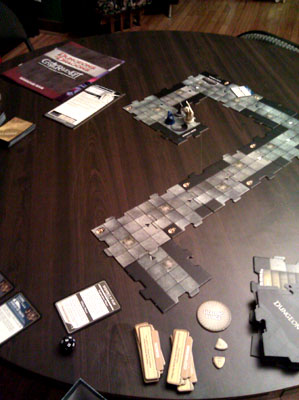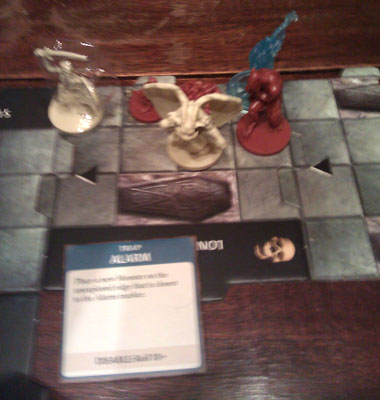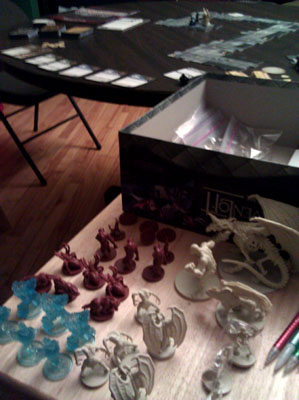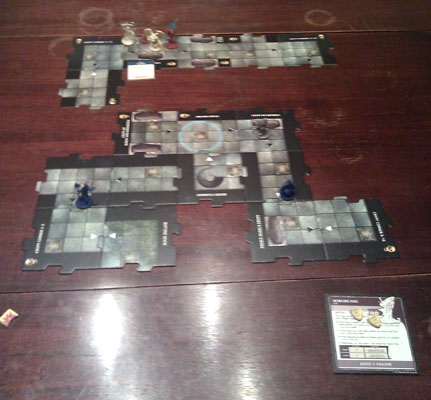January 7th, 2011
CASTLE
RAVENLOFT
As a roleplaying game, 4th Edition sure makes a
great boardgame.
... Zing!
But in all seriousness, I've been looking forward
to getting my grubby
paws on a copy of the new Castle
Ravenloft
game for awhile now. For the better part of two
decades now, I've been looking for a boardgame that could be played
when you were in the mood for a little dungeon-crawling but didn't have
anyone to DM.
(Over the years I've dabbled with dungeon-crawling
boardgames that require DMs, but I've pretty much sworn off them at
this point.
Descent
is a decent game, for example, but I can't imagine a scenario when I
would ever play it: Since it requires a DM, I might as well just grab
my copy of Dungeons
& Dragons off the shelf. The full-fledged RPG is
a richer and more rewarding experience in almost every way, and with
the speed of OD&D character creation you can actually get the
game set-up and start playing much quicker, too.)
Most recently, Munchkin
Quest looked like it might fill that slot for
me. It had some pacing issues, but after fixing those problems
the game saw a couple months of intense use. But after that, the game
started collecitng dust: The competitive aspect meant it still wasn't
quite scratching that dungeon-crawling itch. And it was too long (3-5
hours) given the relative shallowness of its gameplay. Way too many
sessions ended with all of us wishing that the game would just end already.
Castle
Ravenloft
is pretty much at the opposite end of that spectrum: The prepackaged
adventure scenarios all feel lightning fast and can easily be completed
in 60 minutes or less. I've played it more than a dozen times already
(having gotten it only a week ago). The real test, of course, will be
whether or not the game endures after the first flush of excitement.
But for the moment I wanted to talk about some of my first impressions.
RANDOM
DUNGEON, BUT SHALLOW EXPLORATION
 The game
features a random dungeon construction: Individual puzzle piece tiles
are laid out as your heroes explore the dungeon. The result can be
quite tense at times as you cross your fingers against drawing a black
tile (which results in a debilitating encounter being drawn), but very
few of the tiles have any kind of special effect or meaningful identity
in a given scenario. The game
features a random dungeon construction: Individual puzzle piece tiles
are laid out as your heroes explore the dungeon. The result can be
quite tense at times as you cross your fingers against drawing a black
tile (which results in a debilitating encounter being drawn), but very
few of the tiles have any kind of special effect or meaningful identity
in a given scenario.
So while the game is more variable and interesting
than dungeon-crawlers featuring pre-determined dungeon layouts, there's
also no sense of actually exploring
the dungeon in most of the scenarios.
Similarly, because the dungeon layout is random it
doesn't really matter where you go: You virtually never hit a dead end,
and at some point you will draw the location tile containing your goal
for the given scenario.
Here's a simple hack I may be trying in the near
future: For scenarios involving the use of the special 1x2 Start Tile
(which is most of them), start by forming a random 3x4 grid of
face-down dungeon tiles with the Start Tile in the middle of them. Now
take any scenario-specific tiles and shuffle them into a stack of
random dungeon tiles to form a stack of 13 additional dungeon tiles.
Deal these out randomly to form a face-down, 5x5 grid (including the
original 3x4 grid). (For a longer game, form a 6x6 grid instead.)
TACTICS,
BUT NOT AS WE KNOW THEM
 Although Castle Ravenloft
offers a setup superficially similar to 4th Edition, this can actually
be quite deceptive. As a result, I've seen quite a few reviews complain
that Castle Ravenloft
doesn't have any tactical depth. Although Castle Ravenloft
offers a setup superficially similar to 4th Edition, this can actually
be quite deceptive. As a result, I've seen quite a few reviews complain
that Castle Ravenloft
doesn't have any tactical depth.
This is not, strictly speaking, true: Castle Ravenloft
does have tactical depth; it's just a tactical depth that looks
absolutely nothing like 4th Edition's tactics.
The primary tactical crux of Castle Ravenloft
lies in the fact that heroes move by spaces but monsters by tile. (For example,
a typical hero might move 5 spaces on their turn. A typical monster, on
the other hand, will move 1 or 2 tiles.) Thus, the core tactics of the
game revolve around managing the placement of monsters and heroes
around the tile borders.
These basic tactics are complicated by the
necessity to manage the monster's control sequences; the panoply of
variable hero abilities; and the random crises generated by a
fair-sized chunk of the game's encounter cards.
(The game may also suffer in the opinion of some
because it's very easy to brute-force your way through the early,
introductory scenarios. It's thus possible to completely ignore the
tactics and strategy of the game and still pull out early victories,
leading one to the false conclusion that the game has no strategy. In
that respect it's kind of the inverse of Settlers of Catan
-- a game which you think has a strategy when you first start playing
it and then eventually realize is dominated completely by dumb luck.)
HORRIFIC
RULEBOOK
The Castle
Ravenloft rulebook is quite possibly the worst I've ever
read. It's poorly organized, fails to explain basic terminology,
establishes other terminology which it then proceeds to use
inconsistently, and then compounds all of these problems with an
atrocious (lack of) organization. And given the relative simplicity of
the rules, the experience of the designers, and the fact that the game
is built on the back of a fairly well-established ruleset... well, it's
completely inexcusable.
It's also disappointing that WotC failed to
leverage their existing stock of high quality fantasy art to spice up
the cards. The lack is particularly felt, in my opinion, when it comes
to the treasure cards.
MONSTERS
& SCENARIOS
 The argument
could certainly be made that it's worth buying the game just for the 42
miniatures that come with it. I don't think I'd disagree: Amazon is
selling the game for $50 right now, so the price per mini comes out to
about $1.20. Since that includes a Huge Dracolich, I'm pretty happy
with it. (And that's ignoring the general utility of the interlocking
dungeon tiles.) The argument
could certainly be made that it's worth buying the game just for the 42
miniatures that come with it. I don't think I'd disagree: Amazon is
selling the game for $50 right now, so the price per mini comes out to
about $1.20. Since that includes a Huge Dracolich, I'm pretty happy
with it. (And that's ignoring the general utility of the interlocking
dungeon tiles.)
Laying that aside, I do wish the game had a bit
more variety when it came to monsters. There are basically ten
varieties of "grunt" in the game (zombie, skeleton, blazing skeleton,
wraith, ghoul, wolf, kobold, spider, rat swarm, gargoyle) and you'll
see a lot of them all. While the varied scenarios are keeping much of
the game fresh for me right now, the monsters have all become rather
hum-drum.
Fortunately, this is an aspect of the game which
is surprisingly easy to customize. Although game balance probably
requires that you keep 10 different types of creature for each
adventure, swapping them out for equally challenging monsters isn't a
problem. There's a ton of fan-created monsters already available, and
there are cheap D&D mini singles available all over the place.
Speaking of scenarios, the game comes with 12
(including two solo scenarios) and 2 more have been released through
Wizard's website. The scenarios are varied (often completely changing
your strategic approach to the game) and have been easily supporting
multiple play-thrus for me. For example, in this scenario:

The heroes start
play having been randomly teleported to different corners of the
dungeon. You have to reunite with each other and shut down a demonic
summoning while the villain of the piece continues to assault the
heroes with teleportetic assaults.
(In the image
above you can see where we've set off an Alarm trap -- which summons
additional monsters each round -- in a section of the dungeon we were
subsequently teleported out of. One of the (blue) heroes has been
abandoned in a dead end corridor. And both of the heroes are dreading
the possibility that the villain is going to teleport them back up to
where all those monsters are waiting to devour them.)
But I do wish there were more of them. When I
compare the relatively anemic number of scenarios offered by Castle Ravenloft to
the dozens of
scenarios offered by Betrayal at House on the Hill
(another game I received this Christmas which features variable
scenarios of roughly equivalent complexity), I do feel this was an
opportunity missed by the designers.
FINAL
WORD (FOR NOW)
Castle
Ravenloft is fun.
I'm enjoying it a lot, and I keep roping in more
and more people who all seem to agree.
It's not perfect, but its only egregious flaw (the
atrocious rulebook) is relatively easy to overcome.
Having just reviewed my early thoughts on Munchkin Quest, I
realize that initial success may not translate into a permanent or even
long-term success. But as I write this I've already gotten more than a
dozen plays out of the game, and I've only touched half the scenarios
it shipped with. A couple scenarios have already seen 4+ plays. Even if
that's where the game tops out, I'll still get 40+ plays out of it.
That's pretty good compared to most of the games I own.
| 
